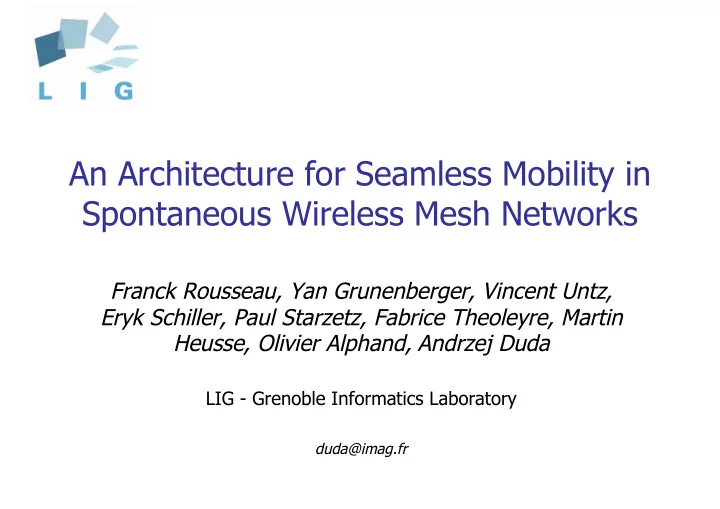

An Architecture for Seamless Mobility in Spontaneous Wireless Mesh Networks Franck Rousseau, Yan Grunenberger, Vincent Untz, Eryk Schiller, Paul Starzetz, Fabrice Theoleyre, Martin Heusse, Olivier Alphand, Andrzej Duda LIG - Grenoble Informatics Laboratory duda@imag.fr
Overview Spontaneous wireless mesh networks Principles of seamless mobility Pseudo-geographical addressing space Geographical Ballistic Routing Joining the mesh and handoff Conclusions 2
Spontaneous mesh mesh router mobile node Self-forming - follow human structures Autonomic - no (or limited) administration Dense, large scale, not only for Internet access 3
Principles of seamless mobility Separation between Identities and Addresses node identified by stable end-point A 2 mesh identifier EID routers address reflects current position EID A 1 EID-ADDR binding stored in a distributed Location Service mobile node Optimized for local mobility the most common case - movement in a closed vicinity lazy location update - do not notify about small position changes 4
Main design choices Addresses in a coordinate space virtual topological space anchored with some geographical positions - pseudo-geographical coordinates : d virt (A 1 , A 2 ) ~ d real (A 1 , A 2 ) possible merging of subspaces Geographical routing in the coordinate space take advantage of little routing information avoid drawbacks of greedy geo-routing Local fish-eye view precise knowledge of your neigborhood approximate view of distant destinations 5
Principles of the architecture 6
Addressing space - spring model Nodes estimated with exact positions geographical position (GPS or position to configured) estimate estimated transmission range position Spring model minimize a known position potential function that depends on node positions 7
Greedy geographical routing greedy optimal D S face routing obstacles Greedy routing forward to a neighbor closer to the destination problems: voids or obstacles recover from local minima: face routing (right-hand rule and face changing), still may be not optimal 8
Geographical Ballistic Routing Build upon topologically consistent address space Combine two approaches long distance geographical routing short distance topological routing Long distance - geo-routing known direction route is known globally, implicitly (rough direction to destination) Short distance - topo-routing known topology of the k -neighborhood route is known locally, explicitly (k-hop neighbors) 9
Geographical Ballistic Routing k-neighborhood D S angle θ obstacle 10
Joining the mesh Fast lightweight association mesh router mesh routers send beacons MAC addresses, channels, load indicators Immediate basic connectivity mobile can send packets to reach a community, A 1 if mobile is accepted, mesh router EID 1 updates Location Service with mobile EID and router Address mobile can then receive packets via mobile node mesh router k -neighborhood of router A 1 11
Handoff packets to A 2 packets to A 1 A 2 mesh routers packets to A 1 A 1 k -neighborhood EID 1 of router A 1 Fast lightweight handoff choose a neighbor (A 2 ), send HANDOFF request to A 1 A 2 starts forwarding packets A 2 is close - packets to EID 1 still sent to A 1 , but diverted to A 2 lazy update of the Location Service 12
Conclusions Simple yet powerful basic principles: mobility management based on separation of EIDs and addresses pseudo-geographical addressing space enabling directional routing fast association and handoff lazy location update Preliminary work: simulation of the addressing scheme and geographical forwarding, first implementation on Linux Future work: refinement of the design, full implementation of geo-routing and mobility 13
Recommend
More recommend